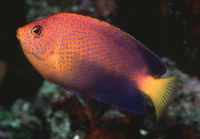Difference between revisions of "Centropyge interruptus"
From The Aquarium Wiki
| (One intermediate revision by one other user not shown) | |||
| Line 26: | Line 26: | ||
|min_sg=1.020 | |min_sg=1.020 | ||
|max_sg=1.025 | |max_sg=1.025 | ||
| − | |min_tank_size= | + | |min_tank_size=70 |
|min_tank_size_unit=G | |min_tank_size_unit=G | ||
|min_ph=8.1 | |min_ph=8.1 | ||
|max_ph=8.5 | |max_ph=8.5 | ||
| − | |min_temperature= | + | |min_temperature=68 |
| − | |max_temperature= | + | |max_temperature=74 |
|temperature_units=F | |temperature_units=F | ||
|min_water_hardness=8 | |min_water_hardness=8 | ||
|max_water_hardness=12 | |max_water_hardness=12 | ||
}} | }} | ||
| − | + | ||
| − | + | == Origin == | |
| − | + | :Found in the Pacific Ocean concentrated around southern and central Japan and the northwestern Hawaiian Islands (Midway and Kure).<ref>{{FishBase |id=10990}} Distribution</ref> | |
| + | |||
| + | |||
| + | == Sexing == | ||
| + | :Females will have blue speckling across their whole body, males just on the face. | ||
:In 1978 Moyer and Nakazono showed ''Centropyge interruptus'' to be a protogynous hermaphrodite - in other words, they enter the world without a sex. As they mature, they first take on the female sex organs. Similar to other protogynous hermaphrodites, the male is the result of a dominant female that has undergone a sex change due largely to a male that has either died or disappeared in some manner.<ref>[http://www.reefkeeping.com/issues/2003-02/hcs3/index.php Reefkeeping.com] What a Darling Little Angel: The Genus Centropyge</ref> | :In 1978 Moyer and Nakazono showed ''Centropyge interruptus'' to be a protogynous hermaphrodite - in other words, they enter the world without a sex. As they mature, they first take on the female sex organs. Similar to other protogynous hermaphrodites, the male is the result of a dominant female that has undergone a sex change due largely to a male that has either died or disappeared in some manner.<ref>[http://www.reefkeeping.com/issues/2003-02/hcs3/index.php Reefkeeping.com] What a Darling Little Angel: The Genus Centropyge</ref> | ||
| − | + | ||
| − | + | ||
| − | + | == Tank compatibility == | |
| − | + | :As with many Dwarf Angels, the Japanese Angel is best kept the only Angel to a tank unless the tank is very large (over {{gal|100}}). They should not bother smaller more peaceful fish. | |
| − | + | ||
| + | |||
| + | == Diet == | ||
| + | :Mainly grazes on algae, will also accept [[spirulina]] and Meaty foods. | ||
| + | |||
| + | |||
| + | == Environment specifics == | ||
| + | :Needs a mature tank with algae covered live rock to thrive. | ||
| + | |||
| + | |||
| + | == Identification == | ||
| + | :Typical oval Angelfish shape, the body is bright orange in base colour with neon blue speckles and a yellow caudal fin. | ||
| + | |||
| + | |||
{{Categories | {{Categories | ||
|Category=Fish, Fish (Saltwater), Angelfish (Saltwater) | |Category=Fish, Fish (Saltwater), Angelfish (Saltwater) | ||
Latest revision as of 23:09, 15 June 2020
Japanese Angelfish
Centropyge interruptus
265 Litres (70 US G.)
12.7-15.2cm (5-6 ")
8.1 - 8.5
20-23.3°C (68 -74 °F)
8-12 °d
1:1 M:F
2-5 years
Family
Pomacanthidae
| You can contribute to the Aquarium Wiki by expanding this article. Dont be shy!. |
Contents
Additional names
- Japanese Angelfish, Japanese Pygmy Angelfish
Additional scientific names
- Angelichthys interruptus, Centropyge interruptus
Origin[edit]
- Found in the Pacific Ocean concentrated around southern and central Japan and the northwestern Hawaiian Islands (Midway and Kure).[1]
Sexing[edit]
- Females will have blue speckling across their whole body, males just on the face.
- In 1978 Moyer and Nakazono showed Centropyge interruptus to be a protogynous hermaphrodite - in other words, they enter the world without a sex. As they mature, they first take on the female sex organs. Similar to other protogynous hermaphrodites, the male is the result of a dominant female that has undergone a sex change due largely to a male that has either died or disappeared in some manner.[2]
Tank compatibility[edit]
- As with many Dwarf Angels, the Japanese Angel is best kept the only Angel to a tank unless the tank is very large (over 379 Litres (100 US G.)). They should not bother smaller more peaceful fish.
Diet[edit]
- Mainly grazes on algae, will also accept spirulina and Meaty foods.
Environment specifics[edit]
- Needs a mature tank with algae covered live rock to thrive.
Identification[edit]
- Typical oval Angelfish shape, the body is bright orange in base colour with neon blue speckles and a yellow caudal fin.
Pictures[edit]
References[edit]
- ↑ Fishbase (Mirrors:
 )
Distribution
)
Distribution
- ↑ Reefkeeping.com What a Darling Little Angel: The Genus Centropyge
External links[edit]
- Fishbase (Mirrors:
 )
)

